In a city where going to a trendy restaurant or ordering Seamless has become the default and small talk with strangers feels like a lost art, supper clubs are making waves. From cramped apartments in Bushwick to century-old synagogues on the Lower East Side, a new generation of hosts is turning strangers into friends, one shared meal at a time. These are intimate gatherings where the real magic happens in the conversations that unfold between courses. The hosts are former tech workers, medical students, and documentary producers who've discovered that in our hyper-digital world, there's nothing more radical than inviting strangers over for dinner.
The Origin Stories: From Pandemic Pivots to Childhood Dreams
The Producer Who Pivoted: Jacqueline Lobel, founder of Shtick — which launches in the Lower East Side very soon — watched historic Jewish New York shops disappear while Jewish food culture "shrunk down to pickles and bagels with lox." She spent a decade producing and directing documentary TV, but when the pandemic killed her job, everything changed. She rented a wooden pushcart from an off-Broadway Fiddler on the Roof production and served borscht shots, potato salad and everything bagel hot dogs to 150 people on the Lower East Side.
The Laid-Off Tech Worker: After losing her tech job in 2023, Nirupa Konijeti, founder of Bazaar, had a "rare moment of stillness" where she asked herself what she actually wanted to do. The answer: feed people in her apartment. Hosting felt like a natural extension of who she was, and even though she was nervous — and changed the menu several times — she knew she just needed to get through the first dinner.
The Medical Student Chef: Akhil Upad felt creatively limited executing someone else's vision in restaurant kitchens. After a private dinner in Boston where guests lingered in the kitchen asking questions, he turned to his partner Aditya, and asked a big question: "What if we did this monthly at my place?" Now, he’s a medical school student who runs The Sewing Tin, a supper club, with Aditya, a cook at Three-Michelin-Starred Le Bernadin.
The Category Creator: “I don't have a restaurant. I don't want to have a restaurant, and it's not a restaurant," insists Jonah Reider, founder of The Spot. Instead, he creates "inexplicably pleasant experiences" that people can’t stop talking about in a downtown loft. He also wants people to know he’s technically not running a supper club, but he initially generated buzz when he ran a supper club out of his Columbia dorm room.
The Collaborative Duo: Madison Scott and Julian Tineo met while bartending in Bushwick in 2021. The fast friends never intended to charge for their dinner parties. They just loved cooking for friends and bringing people together. Both grew up in families where cooking was central, learning knife skills at a "dangerously young age" and helping with pounds of seafood prep by age seven. After Madison hosted a successful 15-person dinner in her tiny apartment and teamed up with Julian for an even bigger success, Heirloom Supper Club was born.
The Accidental Host: Gabrielle Macafee of Lucky Dinner Club moved into a gorgeous apartment with a huge kitchen and "a massive slab of marble in the middle of it" that "begged to be cooked in." She invited eight friends over — none knowing each other — and cooked a Spanish feast inspired by her Madrid-born father. "There was so much magic in that first dinner,” she said. “We all ended up crying and laughing together by the end," she added, remembering that she didn’t have enough plates. Three and a half years later, she's hosting monthly dinners for 25-45 people.
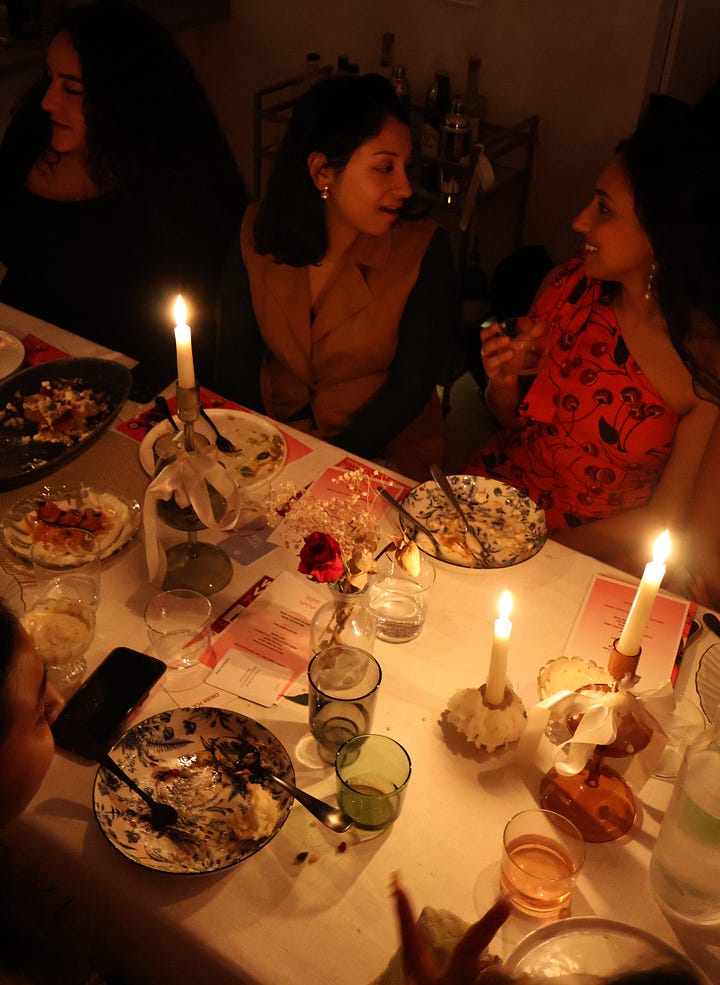
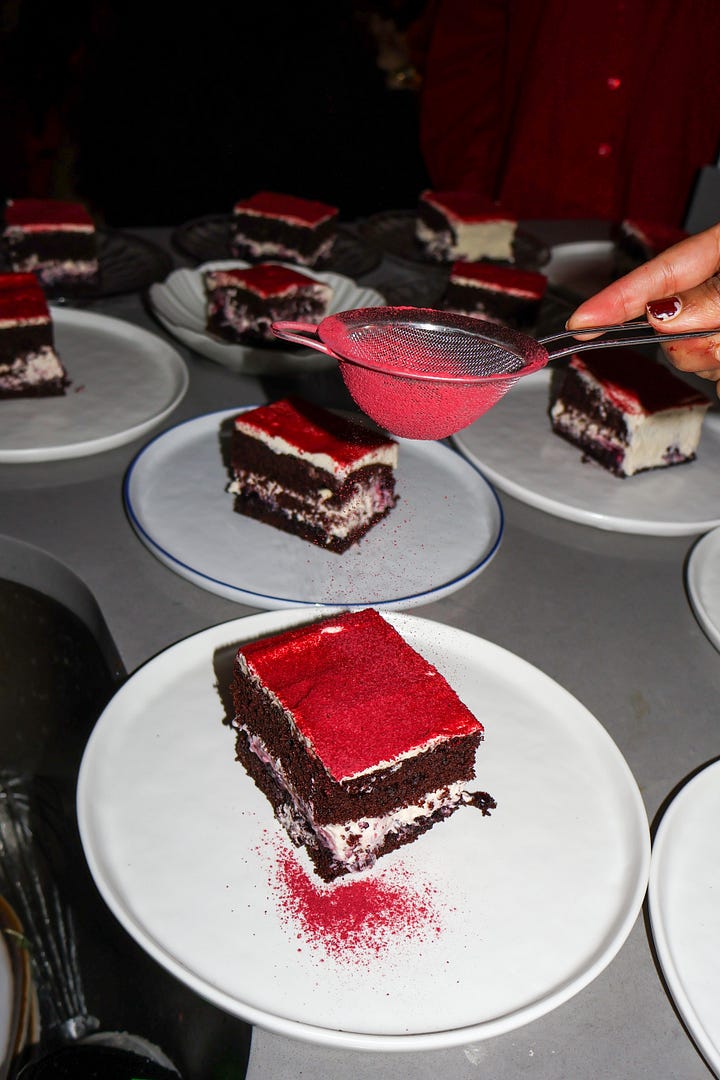
The Economics: From Breaking Even to Selling Out
There’s a delicate balance between accessibility and sustainability, and most supper club hosts land between $85-150 per person for multi-course meals with drinks.
Supper on a Sliding Scale: In an effort to make the experience accessible, Heirloom Supper Club uses a pay-what-you-can sliding scale model, starting at $65. “We think $65 is a good deal for a full-service four-course dinner but realize that’s still a lot for many people,” Madison said.
Learning Along the Way: The Sewing Tin co-founders changed the price of their dinner from $125 to $195, a shift that “reflects just how much the experience has evolved,” Akhil says. “What began as a dinner in an apartment is now a fully-produced evening, hosted in a creative studio in Brooklyn with a team of eight,” he added. The Sewing Tin only hosts one or two dinners per month, and tickets usually sell out within 15 minutes.
Keeping It Affordable: Gabrielle, founder of Lucky Dinner Club, tries to keep the price for her dinners at $100. “You can have a meal at some flashy TikTok famous restaurant for $100, but it lacks the value of being able to break the fourth wall to establish real, human connection," she said.
We charge $125-150 per person which includes a full multi-course meal and basically unlimited wine. I strive to keep the experience accessible and fairly priced, and this was the number that frankly allows us to break even. I do wish it could be less.
— Jacqueline Lobel, founder of Shtick
The Spaces: Synagogues, Studios, and Secret Worlds
Sacred Spaces: Shtick has hosted in multiple synagogues, including cramming 45 people into a narrow 100-year-old sanctuary in the Lower East Side.
Home Advantage: Bazaar and Heirloom both swear by apartment hosting. As Nirupa puts it, "There's something about being in someone's home that just softens people."
Creative Collaborations: The Sewing Tin found their perfect match in Stains Studio, a creative space in Bushwick that "enhances the immersive nature" of their dinners.
Set Design Philosophy: Jonah Reider thinks of his work as creating "beautiful, comfortable sets for theater to unfold.” His space, The Spot, a private penthouse loft, is located on Mulberry Street, and Reider describes the location as “the intersection of Chinatown, Little Italy and Soho.”
The Magic Number: Why 18-20 People Is the Sweet Spot
Despite hosting anywhere from six to 150 guests — which is the size of some weddings — a lot of supper club hosts gravitate toward hosting about 18-20 people. I asked the supper club hosts about their magic numbers.
Nirupa — Bazaar: "Usually around 18. It’s big enough to meet a bunch of people and small enough that it still feels intimate."
Gina — a private chef who cooks for supper clubs: "My happy number is 20. It's the sweet spot where it feels like a real event, but still intimate. It’s big enough to create energy in the room, but small enough to feel personal."
Madison — Heirloom Supper Club: “We’ve found our ideal group size to be 15 to 20 people. For us, this has been the sweet spot when it comes to storytelling during the dinner, ordering ingredients and scaling up recipes for dishes that we enjoy making for ourselves and friends. It also gives us a chance to talk to many of our guests at some point during the night.”
Gabrielle — Lucky Dinner Club: While most hosts gravitate toward 18-20 people, Gabrielle goes bigger. “Anywhere from 25-45 people, but the sweet spot is 30.” she says. “Ideally in a space that's juuuust too small for everyone, always the most fun."
The science of connection all comes down to a guest list that’s large enough for vibrant energy, but small enough for everyone to have conversations and connect.
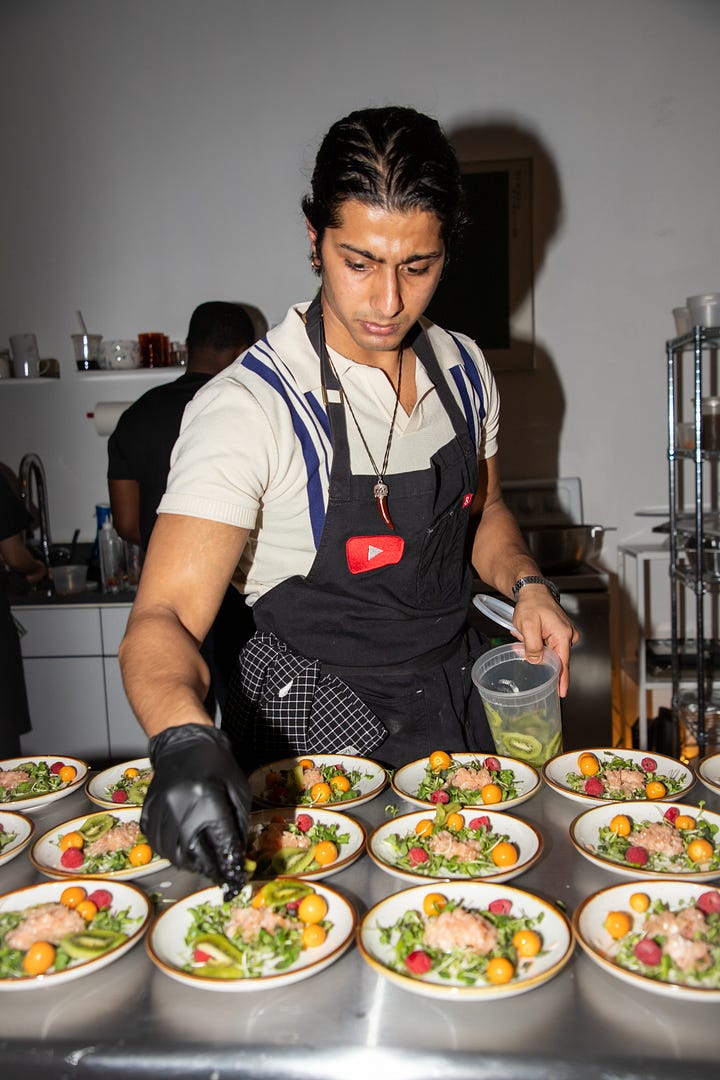
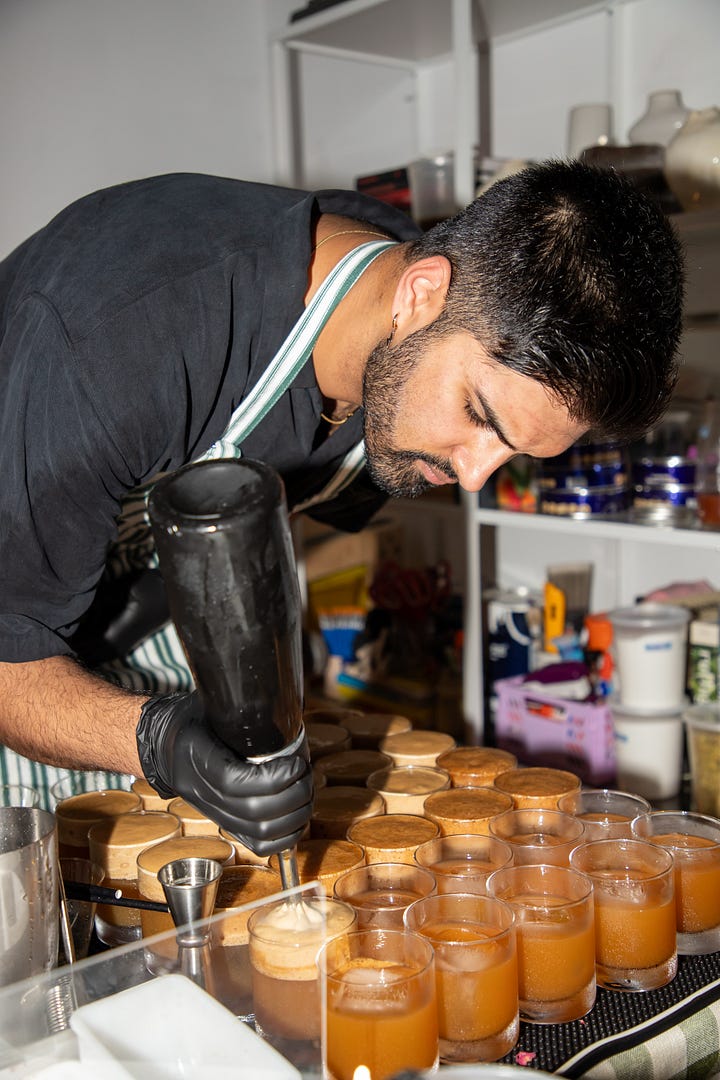
The Preparation: Markets, Trials, and Midnight Fish Prep
The All-Nighter: Seafood is the last piece of the puzzle for The Sewing Tin. The team places their order the night before and it’s delivered to one of their team member’s restaurants. After Aditya’s shift at Le Bernadin, usually around 1 a.m., he heads over to the restaurant, and they break down the fish, cure it, portion it and call it a night.
The Analog Approach: Jacqueline still manages all Shtick’s reservations through her personal email. "It can be a lot, but it's a lovely way to connect with guests before meeting them IRL," she says. She also wakes up "as early as humanly possible" to buy flowers at the 28th Street market every morning before an event.
Market-Driven Menus: Heirloom starts menu planning at the Union Square farmers market, building around seasonal ingredients. The duo also pulls a lot of inspiration from particularly great meals they’ve had in NYC, while traveling or from chefs and restaurants they admire. From there, they sit down together and start with a list of ingredients or flavors they know they want to incorporate into the menu.
The Trial Run: About one to two weeks before each dinner, The Sewing Tin team runs a full menu trial. “It’s like a one day season of Chopped,” Aditya said. “We plate each dish, taste in silence, and then debate: tweaking flavor, temperature, texture, even the story behind each bite. Nothing goes on the table until it feels right.”
Building Kitchens Anywhere: Lucky Dinner Club's Gabrielle gets creative with venues. "I've built kitchens in art galleries, photo studios, in the woods, I'm scrappy!" Her process is "scattered" but starts with a theme, an inspiring bite, or someone offering a venue.
The Guest Experience: Name Tags, Booze, and the Phone Phenomenon
Breaking the Ice: Simple tactics work best, but connecting with fellow guests is important. Heirloom uses name tags, while Bazaar relies on aperitifs and ice breakers.
The Phone Mystery: "No phones at the table is not a rule, but it's something I've noticed — and I love it," Jacqueline observes. Being present makes all the difference.
Stranger Magic: You never know who you’ll meet, and that’s the magic of it all. Nirupa's most memorable moment was when two of her guests discovered their mothers grew up on the same street in Mumbai.
The Butter Compliment: Gina's favorite feedback came from a guest who wanted to take the homemade butter home. "Even the tiniest details can leave the biggest impression,” she said.
The Juggling Act: Chef, Host and Everything In Between
The biggest challenge? Being everything, everywhere, all at once.
The Impossible Balance: "The balance of cheffing and hosting can be tricky," Gabrielle of Lucky Dinner Club admits. "I'm the host and (usually) the chef, so I'm not always there for guests to lean on. However, I always step out from the kitchen to introduce myself to each guest, and try to help them integrate into conversations."
Team Building: A lot of supper club hosts recruit their friends and family to help make the magic happen. As Madison of Heirloom simply put it, "We love our friends so much." Past guests at Bazaar have even started volunteering at new dinners — "helping plate, clear, take photos. It's become this beautiful little ecosystem of people paying it forward,” Nirupa says.
The Disappearing Act: Some hosts rarely sit down to eat their own food. "I never sit or hardly eat at my dinners," says Jacqueline of Shtick. "When I'm not running around, I'm scanning the room anticipating needs." For Gabrielle, any moment she can step away is precious: "Any moment I can pour some wine, have a chat with a guest, I'll take it."
Professional Support Systems: The Sewing Tin has built a full team of eight to handle their elaborate productions. "Our manager, Maria Mir, keeps everything running behind the scenes so we can stay present in the moment," explains Aditya. For larger events, private chef Gina brings in extra hands "so I can stay focused in the kitchen, but I'm almost always deep in the cooking zone."
The Unexpected Moments: Power Outages and Michelin Stars
The Test of Partnership: The Sewing Tin's Aditya once threw away an eight-hour sauce Akhil had made. "That was the moment I knew we could really work together,” Aditya said. “We stay calm and bounce back with solutions."
Celebrity Surprise: Bazaar's Nirupa was shocked when Michelin-starred chef Vikas Khanna shared her supper club on Instagram after his friends secretly attended.
The Power Outage: Heirloom lost power in the kitchen during their first dinner but guests never noticed. "It was somewhat stressful at the moment, but looking back, it's great that we were able to adapt," Madison said.
The Matchmaking Side Effect: Lucky Dinner Club's Gabrielle has witnessed unexpected romance: "I know a handful of couples that either met at LDC, or went on first dates at LDC — plenty of uhh more casual flings have been established at my parties though. I'm quite proud of that,” she said.
The Philosophy: More Than Just a Meal
What drives these hosts goes deeper than food.
"What we do at Shtick isn’t about showing off culinary prowess. It’s about how we host. It’s about the full, curated experience."
— Jacqueline, Shtick
"Food is the ultimate icebreaker. We guide guests through the experience with stories: where the dish came from, why we made it, what it means to us. That intimacy sets the tone. And let’s be real — one or two drinks in, and suddenly everyone’s vibing like they’ve known each other for years."
— Aditya, The Sewing Tin
"I want my customers to feel like they're eating at my house. I recognize how comically cliché it is. Everybody says that about their cooking. But for me, it's not just about the food. It’s also about the space."
— Jonah, The Spot
"I used to overthink the guest list, but I realized I wanted the table to feel as open and accessible as possible. And the kind of people who sign up have been incredible — so thoughtful and curious and down to connect."
— Nirupa, Bazaar
The Bottom Line
In an age of digital connection and isolation, supper clubs offer something radical: genuine human interaction around a shared table. They're part dinner party, part performance, part community building — and deeply loved.
Whether it's 18 strangers in a Brooklyn apartment or 45 people eating dinner together in a century-old synagogue, the anatomy of a supper club reveals something beautiful about New Yorkers and their fundamental need to gather, share, and connect.
And it isn't really about the food. It's about creating space for strangers to become friends.
Want to experience this magic yourself? Most supper clubs announce ticket drops on Instagram — set notifications and get ready to move fast.
And thanks for being here and reading this newsletter.

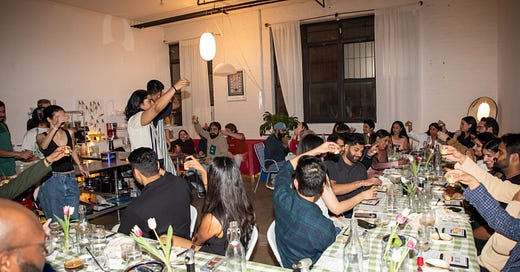



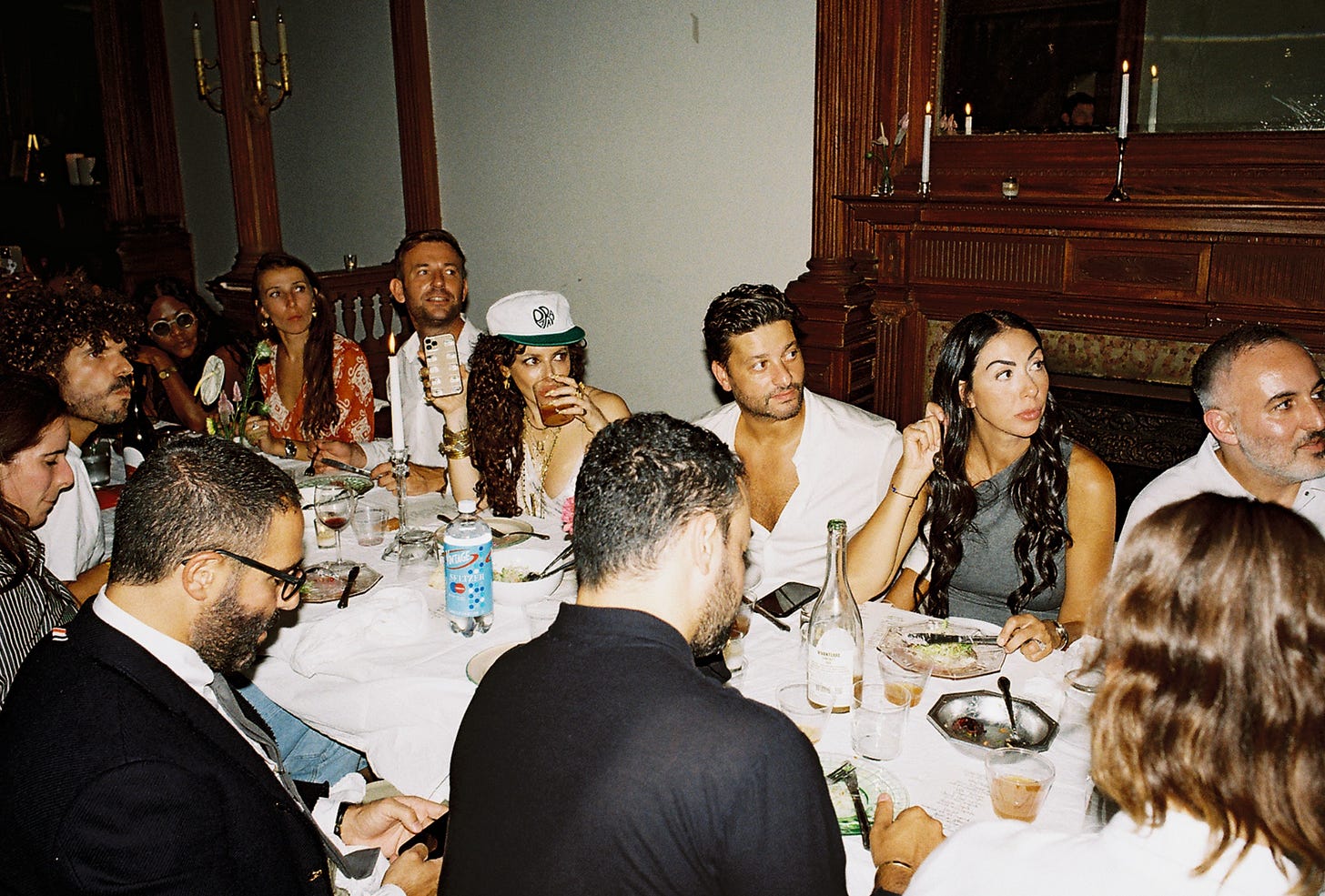
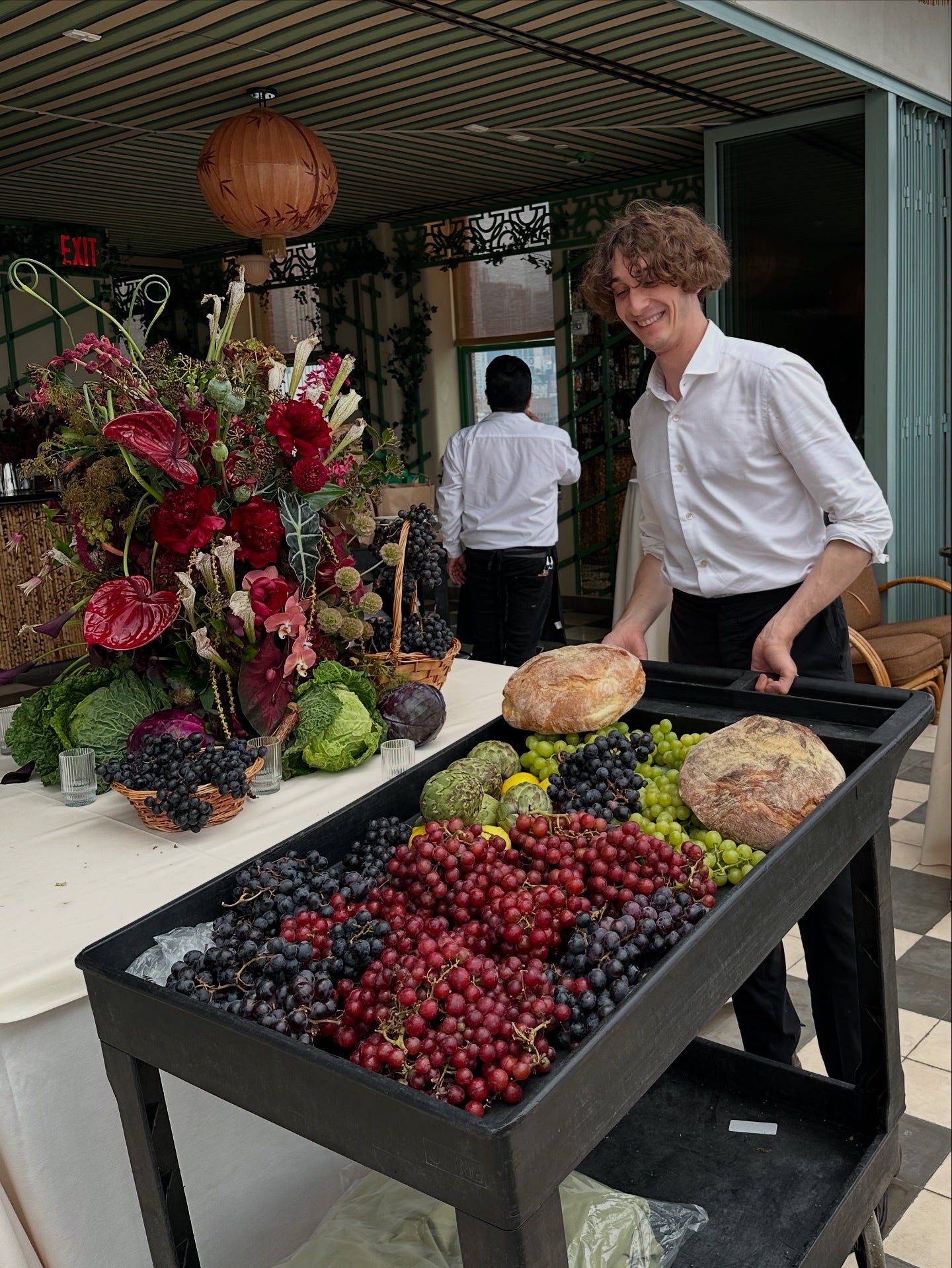



I’ve been meaning to check out Supper Club LA.
love this